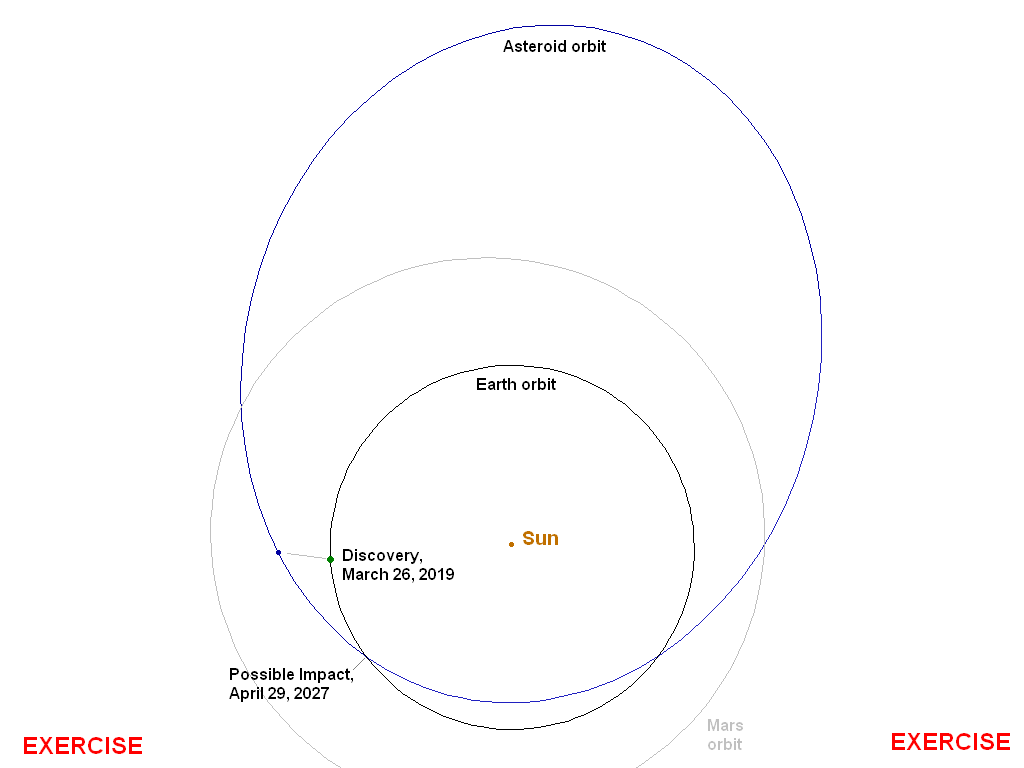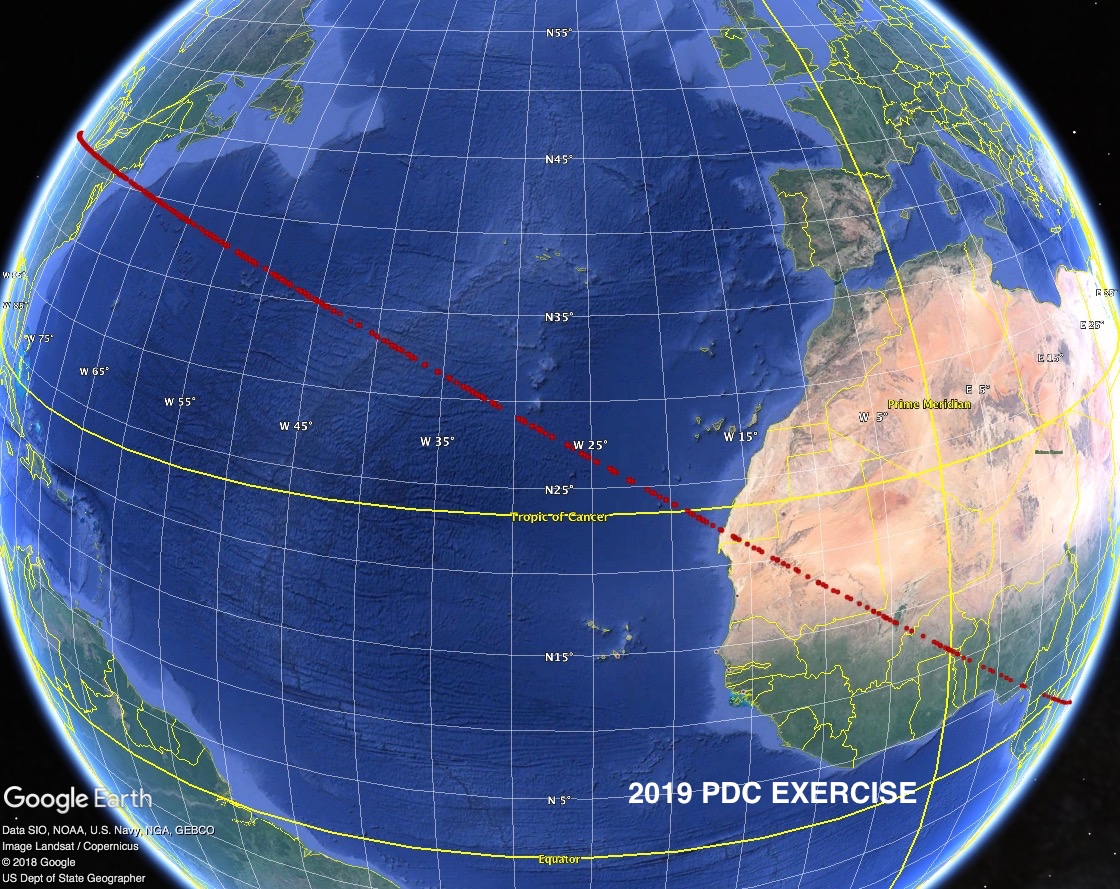



A hypothetical asteroid impact scenario will be presented at the 2019 IAA Planetary Defense Conference (PDC), to be held in College Park, Maryland, USA, April 29 - May 3, 2019. Although this scenario is realistic in many ways, it is completely fictional and does NOT describe an actual potential asteroid impact. The scenario begins as follows:
An asteroid is discovered on March 26, 2019, at magnitude 21.1, and confirmed the following day. It is assigned the designation “2019 PDC” by the Minor Planet Center. (To reinforce the fact that this is not a real asteroid, we are using three letters in the designation, something that would never be done for an actual asteroid.)
Initial calculations indicate that the orbit of 2019 PDC approaches well within 0.05 au of the Earth’s orbit. (The unit “au” stands for “astronomical unit”, which is the mean distance of the Earth from the Sun, 149,597,870.7 km, or 92,955,807 miles.) Since the initial estimate of the asteroid’s absolute (intrinsic) magnitude H is 21.7, it qualifies as a Potentially Hazardous Asteroid (PHA).
The asteroid’s orbit is eccentric, extending from a distance of 0.89 au from the Sun at its closest point to 2.94 au at its farthest point in the middle of the main asteroid belt. Its orbital period is 971 days (2.66 years), and its orbital plane is inclined 18 degrees to the Earth’s orbital plane.
The day after 2019 PDC is discovered, JPL’s Sentry impact monitoring system, as well as ESA’s similar CLOMON system, both identify several future dates when this asteroid could potentially impact the Earth. Both systems agree that the most likely potential impact occurs on April 29, 2027 - over eight years away - but the probability of that impact is very low, about 1 chance in 50,000. With only two days of tracking this object, no more definitive statement can be made.
When first detected, the asteroid is about 0.38 au (57 million kilometers or 35 million miles) from Earth, approaching our planet at about 14 km/s (8.5 mi/s or 31,000 mph), and slowly getting brighter. 2019 PDC is observed extensively for a few weeks after discovery, and as the observational dataset grows, the impact probability for 2027 increases. Three weeks after discovery, when observations pause during full moon, the impact probability has risen to nearly 0.4 percent, or about 1 chance in 250. The asteroid continues to brighten somewhat as it approaches, but it reaches a peak brightness of only 20.3 at the end of April.
Very little is known about the asteroid’s physical properties. Based on the apparent visual magnitude, its absolute (intrinsic) magnitude is estimated to be about H = 21.7 +/- 0.4. Since its albedo (reflectivity) is unknown, however, the asteroid’s mean size could be anywhere from roughly 100 meters to over 300 meters.
2019 PDC approaches the Earth for well over a month after discovery, and it reaches its closest point of about 0.13 au on May 13. Unfortunately, the asteroid is too far away to be detected by radar, and it is not expected to pass close to the Earth again, until 2027.
Astronomers continue to track the asteroid almost every night, and the impact probability for 2027 continues to rise. As of April 29, 2019, the first day of the 2019 Planetary Defense Conference, the probability of impact has climbed to about 1%. The rest of the scenario will be played out at the conference.
Here are additional details on what we know about 2019 PDC on the first day of the conference:

|
| Orbit of Asteroid 2019 PDC |

|
| Position uncertainty of asteroid 2019 PDC on April 29, 2027 (based on observations through April 29, 2019) |

|
| Risk corridor of 2019 PDC - image 1 |

|
| Risk corridor of 2019 PDC - image 2 |
A Google Earth kml file for these impact points is available here.
A table of the impact circumstances of impact points along the central axis of this corridor can be found here. The columns of this table are as follows:
xi & zeta are the Opik b-plane coordinates of the trajectory, in kilometers
Lat & ELon are the latitude and East longitude of the impact point, in degrees
Vel is the velocity at impact, in km/s
Az & El are the azimuth (measured eastwards from North) and elevation of the incoming velocity vector, in degrees
Time is the UTC time of the impact on the impact date, 2027-Apr-29.
The red dots in the risk corridor are Monte Carlo points, which are all essentially equally likely. While there are gaps between the points shown here, the risk corridor is really a continuum, with the impact probability proportional to the average density of the points. Note that the points become more widely spaced towards the ends of the corridor because the asteroid enters at shallower and shallower elevation angles.
The asteroid should remain continuously observable over the remaining months of 2019, although it gets difficult to observe in late May, when it moves as close as 50 deg from the Sun. It will also slowly fade as it recedes from the Earth, requiring fairly large (2-meter-class) telescopes to see it. The asteroid continues to fade during late 2019, reaching 23rd magnitude in October, 24th magnitude in November, and 25th magnitude in December. During that time, observers will require very large aperture telescopes such as the 4- and 8-meter class facilities of CFHT, Keck, Gemini, Subaru, VLT, etc., to track the object. By February 2020, the asteroid will approach 27th magnitude and become essentially unobservable for almost a year, until late 2020.
A special version of the JPL orbit viewer has been created for this object and can be accessed here.
The orbit for the central point of the risk corridor for 2019 PDC has been loaded into JPL’s HORIZONS system, and can be accessed via the name “2019 PDC”. HORIZONS can be accessed with this object preloaded via this web-interface here.
For those familiar with the SPICE Toolkit software, an SPK file for this same orbit has been created and is available here:
ftp://ssd.jpl.nasa.gov/pub/xfr/2019-PDC/2019_PDC-merged-DE431.bsp
The SPK file is consistent with and contains additional DE431 planetary ephemeris information over the time-span 1998-Jan-01 though impact on 2027-Apr-29, permitting retrieval of object state vectors at any arbitrary instant within that timespan.
The orbit for the central point of the risk corridor for 2019 PDC has been loaded into the JPL/Aerospace Corp. NEO Deflection App. This on-line tool allows users to study the velocity change (delta-v) required to deflect the 2019 PDC trajectory away from the Earth, as a function of deflection time. Specific amounts of impulsive velocity change can be applied at specific times before impact and the resulting deflection in the impact b-plane is shown. The App can also be configured to calculate kinetic impactor spacecraft trajectories, as well as the spacecraft masses that can be launched onto those trajectories by various launch vehicles. The App calculates the delta-v applied to the asteroid when the kinetic impactor hits it, and determines the Opik b-plane coordinates, xi and zeta, of the deflected trajectory. Using these coordinates, you can roughly determine the impact point of the deflected trajectory by interpolating in the table of impact circumstances given above. A complete description of the app is available here.
The 2017 PDC trajectory is also loaded into the App along with trajectories of many other simulated Earth impactors.